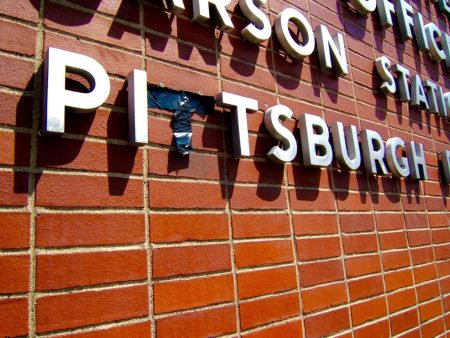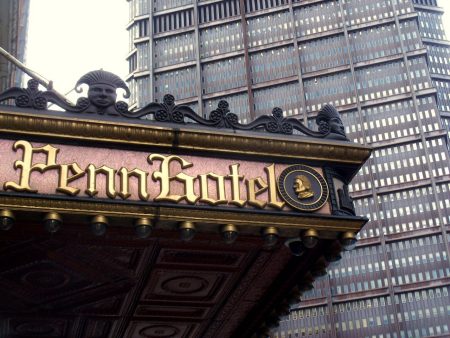Pittsburgh is one city made of hundreds of distinct enclaves. Variation is richness, diversity is beauty.
By Karen Lillis
In the summer of 2023, after living in Pittsburgh for 17 years and listening to what the streets and the poets and the daughters and sons of Pittsburghers had to tell me about the city, I launched a series of Pittsburgh postcards. While some seemed to think of these views as indulgent or curious art shots, I thought of them as containing the Elements of Pittsburgh.

Glass block, Oakland
When Pittsburghers see this photograph, they are sure that it’s their mother’s doctor’s office in Allentown, or that empty storefront down the street from them in Wilkinsburg. But it’s a machine shop in North Oakland just proving my point that glassblock is Very Pittsburgh. Western Pennsylvania, in fact, was once central to the glass industry of the United States.

Awnings, Oakland
Similarly, Pittsburgh viewers take this block of attached houses to be “obviously” situated in Lawrenceville or Swissvale. These aluminum awnings are everywhere on Pittsburgh’s working class row houses and detached dwellings. The untrained eye may not know that Pittsburgh’s own Alcoa was a game changer in transforming this once-precious metal into an affordable, useful, and widely-available material.

Duplex, South Oakland
The beauty in this shot is made of one part turn of the century construction and one part late 20th century decay, or neglect. If you’ve never noticed that neglect is one of the elements that tells the story of Pittsburgh, you haven’t been here very long.

Post Office, South Side
In this shot I see loss, and adaptation. And more aluminum.

Bus stop for Chinatown bus, Oakland
I used to think that the train I often take, which starts in Pittsburgh and ends in New York (or vice versa) was invented precisely for Carnegie and Frick to leave their Manhattan mansions and check in on their factories in Pittsburgh. I was mistaken about the reason The Pennsylvanian train was founded, but the fact remains that Pittsburgh and New York have had entwined histories (and frequent commutes) since the industrial age. The same can be said for Pittsburgh and its immigrants, from China and everywhere else. What would Steel City’s defining industries have been without the workers who came from across the globe to forge the weapons of World War II or the skylines of modernizing cities or the bridges from coast to coast? Today Pittsburgh’s most high profile immigrants are professionals whose expertise runs the city’s comeback industries: Medicine, tech, and academia.

St Paul’s Cathedral, Oakland
Pittsburgh’s substantial population of Catholics is synonymous with the turn of the century wave of immigrants that powered the shop floors of Western Pennsylvania mills and factories: Italians, Hungarians, Polish, Slovaks, Lebanese, Croatians, plus a new influx of Irish and Germans. The power lines in this picture (more dynamic than the Cathedral itself) also make me think of Pittsburgh’s electric industry in particular—George Westinghouse, his robust workforce, and the Electric Valley populated with his employees’ families.

William Penn Hotel with US Steel Tower, Downtown
In this shot I see two of our looming patriarchs crossing paths on Grant Street. Here’s William Penn, the founder of Pennsylvania, whose governing ideas inspired the Constitution and helped lay framework for American democracy. In the background is the ghost of union-buster Andrew Carnegie in the shape of the towering headquarters of U.S. Steel. For that matter, the skyscraper itself is the ghost of U.S. Steel Tower, which is missing its original name if not its eponymous tenant.

Heinz Tomato Ketchup, Bloomfield
We have Heinz as legendary local businessman (son of a Sharpsburg brick maker) who brought himself up by the bootstraps, Heinz as factory employer of many hard-working Pittsburghers, and Heinz as ubiquitous Pittsburgh foodstuff. The condiment comes with a dash of pride in the city’s far-reaching spirit.

Paul Warhola Scrap Metal, North Side
In this one painted sign I see Andy Warhol, I see his Carpatho-Rusyn birth name, I see the siblings he left in Pittsburgh when he split for the Big Apple, I see his brother’s entrepreneurial ethos (not unlike Andy’s) as he created a viable business downwind of Pittsburgh’s manufacturing industries, his hustle as he outlasted those industries.

Italian groceria, Bloomfield
Work brought immigrants to Steel City, and immigrants brought culture, customs, religion, and cuisine. They created communities and imprinted indelible, distinct flavors on the neighborhoods–the pride of Pittsburgh. Spot an awning the colors of the Italian flag on a side street and know that you’ll find homemade pasta, imported anchovies, fresh basil, and bilingual greetings. The next neighborhood over, the grocery might be Lebanese or Korean or Mexican. Pittsburgh is one city made of hundreds of distinct enclaves. Variation is richness, diversity is beauty.
Karen Lillis is a Pittsburgh-based artist, writer, and bookseller. Her photographs have appeared on or in books by Night Ballet Press, Six Gallery Press, and Ugly Duckling Presse, and in publications such as The Austin Chronicle, C-Ville Weekly, The New Yinzer, The Villager, and The Village Voice. She’s worked as a portrait photographer, a rare book photographer, and a performance photographer at the plaza between the Twin Towers. In 2023 she launched a line of Pittsburgh postcards. She is the author of four novellas, including Watch the Doors as They Close (Spuyten Duyvil, 2012) and recently published her first book of photography, Pittsburgh When I’m Hungry (Karen’s Book Row, 2024).






